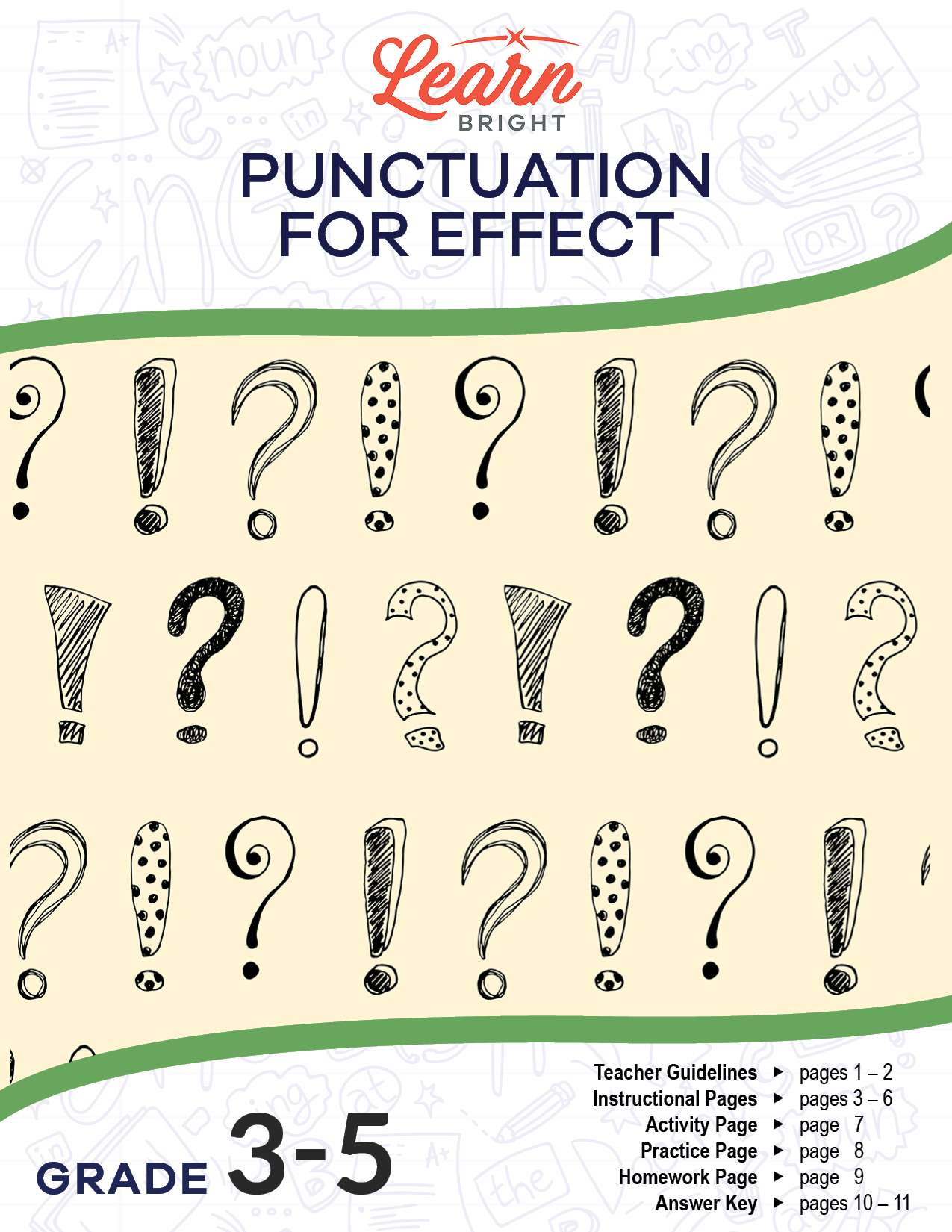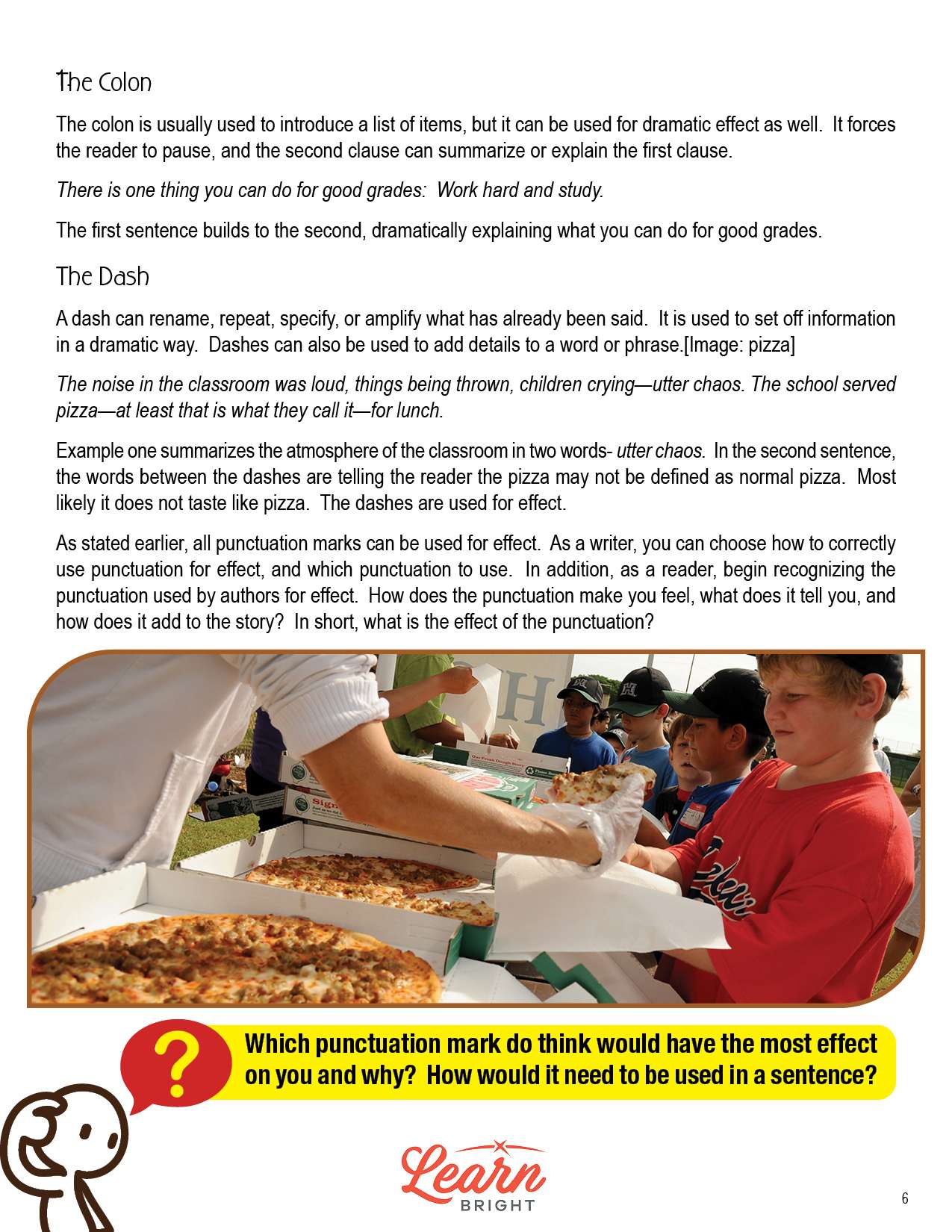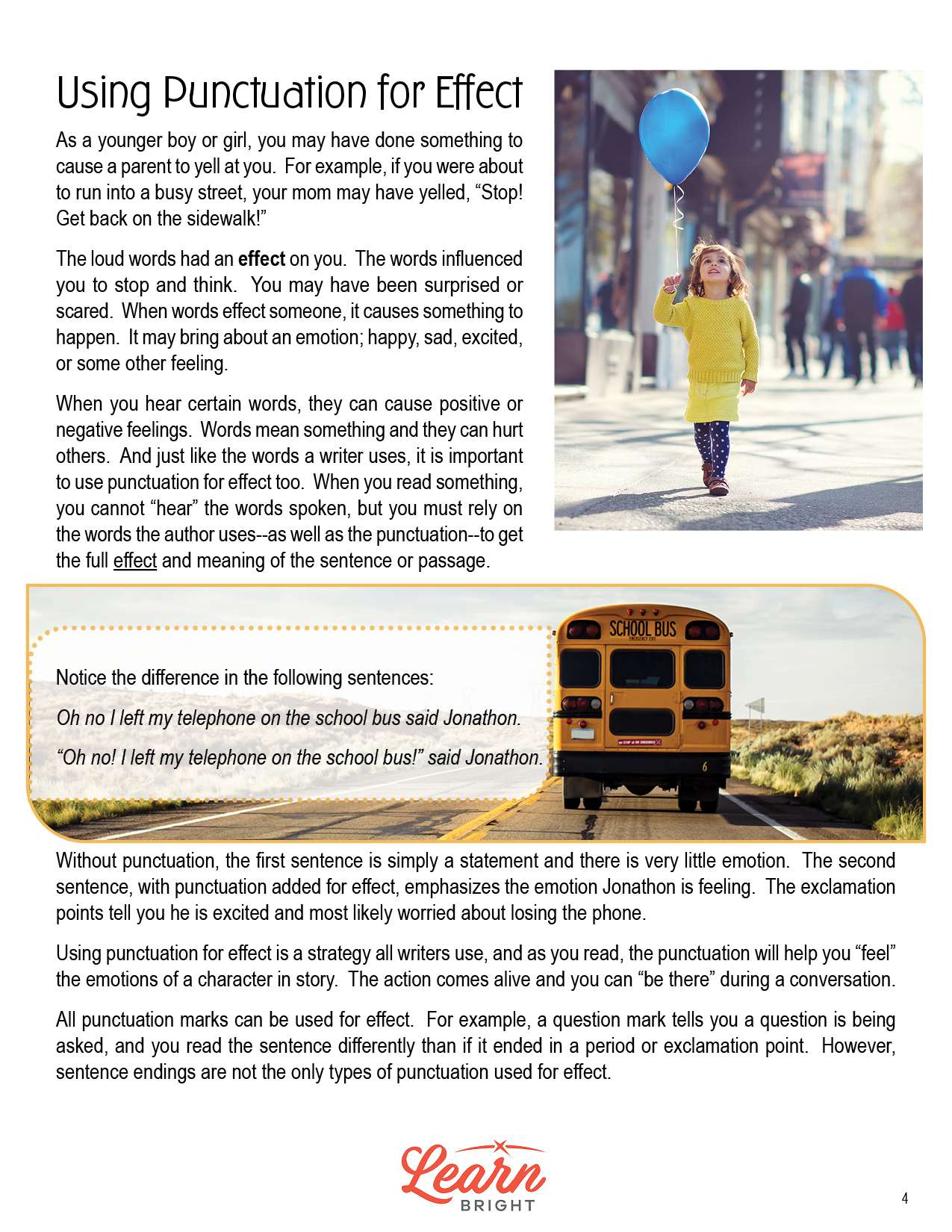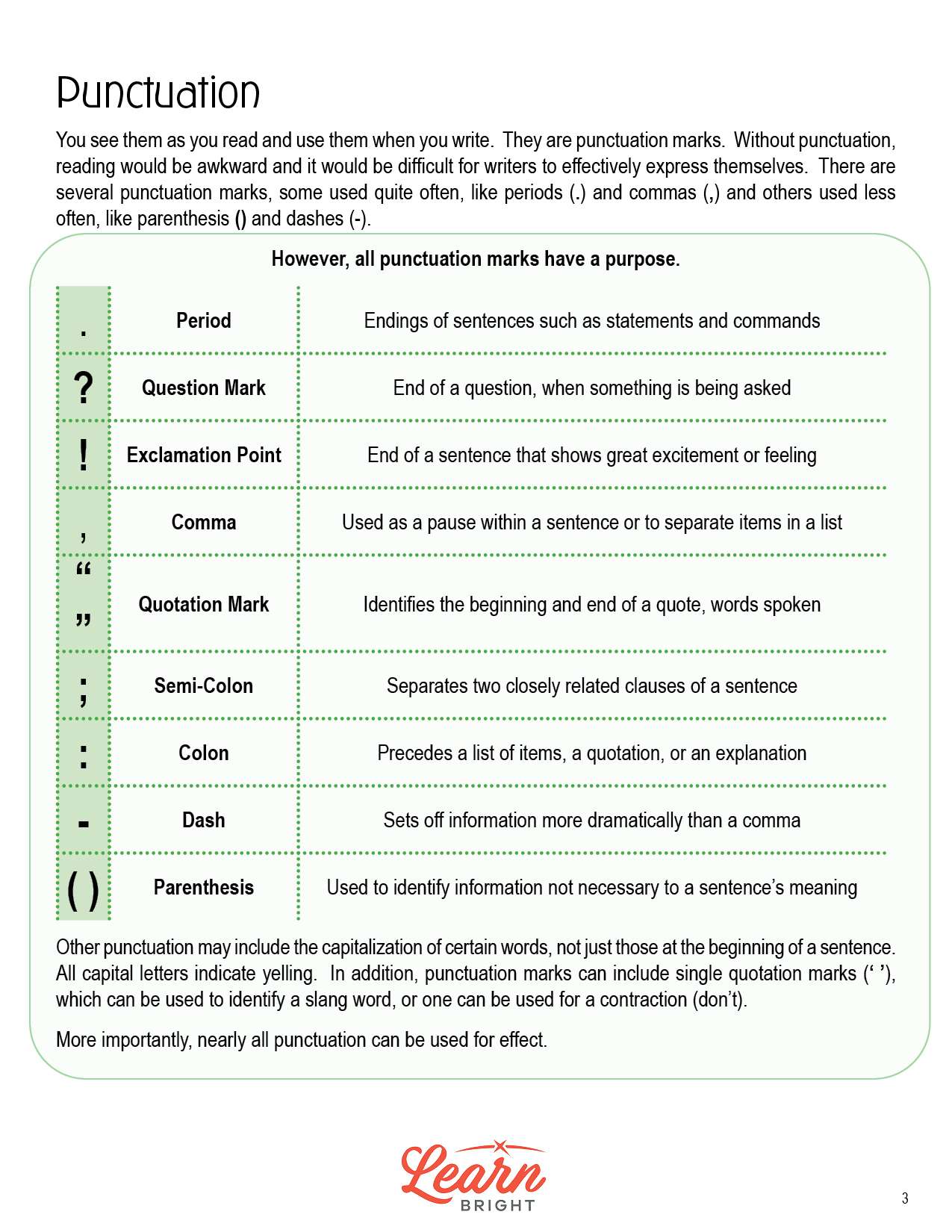Description
What our Punctuation for Effect lesson plan includes
Lesson Objectives and Overview: Punctuation for Effect introduces students to the effect punctuation has on the meaning of a sentence and how to more effectively use different punctuation in their writing. At the end of the lesson, students will be able to correctly use punctuation for effect while writing and when reading. This lesson is for students in 3rd grade, 4th grade, and 5th grade.
Classroom Procedure
Every lesson plan provides you with a classroom procedure page that outlines a step-by-step guide to follow. You do not have to follow the guide exactly. The guide helps you organize the lesson and details when to hand out worksheets. It also lists information in the orange box that you might find useful. You will find the lesson objectives, state standards, and number of class sessions the lesson should take to complete in this area. In addition, it describes the supplies you will need as well as what and how you need to prepare beforehand. The supplies you will need for this lesson are scissors, poster paper, colored pencils, and the handouts. To prepare for this lesson ahead of time, you can pair students for the activity, gather the supplies, and copy the handouts.
Options for Lesson
Included with this lesson is an “Options for Lesson” section that lists a number of suggestions for activities to add to the lesson or substitutions for the ones already in the lesson. The first two suggested adjustments are for the lesson activity. The first is to have students create colorful, decorated punctuation marks for their posters. The second is to assign each pair of students a specific punctuation mark to be the focus of their poster. You can also assign a punctuation mark to each student in your class and have them research its origin. Students can also use their current reading content to identify punctuation and its effect within that content. A final suggestion is to have students write a short story that uses different punctuation marks for effect throughout.
Teacher Notes
The teacher notes page includes a paragraph with additional guidelines and things to think about as you begin to plan your lesson. It notes that it’s important for teachers to remind their students not to overuse punctuation, even when they’re using it for effect. This page also includes lines that you can use to add your own notes as you’re preparing for this lesson.
PUNCTUATION FOR EFFECT LESSON PLAN CONTENT PAGES
Punctuation
The Punctuation for Effect lesson plan includes four pages of content. The lesson begins with a brief overview of what punctuation is. It explains that punctuation marks make it easier for authors to express their meaning. The lesson includes a chart of different punctuation marks and when to use them.
Periods end sentences such as statements and commands. Question Marks end questions, and exclamation points end sentences that show great excitement or feeling. Commas indicate a pause within a sentence or separate items in a list. Quotation marks identify the beginning and end of a quote, or spoken words. Semi-colons separate two closely related clauses of a sentence, while colons precede a list of items, a quotation, or an explanation. Dashes set off information more dramatically than a comma. Finally, parenthesis identify information that is not necessary to a sentence’s meaning.
We use other punctuation, such as capitalization, as well. Using all capital letters indicates that someone is yelling, for example. Single quotation marks can identify a slang word or contraction. We can use all of these forms of punctuation for effect.
Using Punctuation for Effect
You can use punctuation for effect. For example, when you were young, your parents may have yelled at you to stop doing something. These words, spoken loudly, would have had an effect on you and may have caused you to stop. Words, when spoken or read a certain way, can cause emotions, like happiness, sadness, or excitement.
Specific words can also cause either positive or negative feelings. We know word choice is important. The choice of punctuation is important, too! Punctuation tells the reader important information about the way they should read that text and the emotions that the author is trying to convey. It’s necessary for conveying the whole meaning of the text.
The lesson then includes an example of two sentences, one with punctuation and one without. The sentences that includes punctuation is much more expressive, and emphasizes the emotions that the character feels. All writers use punctuation as a tool and strategy. It helps you, as a reader, understand and “feel” the emotions of a character.
You can use any and all punctuation for effect. Question marks tell you that someone is asking a question, which means that you read it differently than if it ended with an exclamation mark or period. Sentence endings, like periods and question marks, are not the only kind of punctuation that you can use for effect.
The Comma
You can use commas as a pause or to separate lists of items. Authors can also use them to indicate a moment where they want you to take a breath while reading. They might want you to slow down while reading so you better understand something or indicate that you should pause but not stop. The lesson includes an example of a paragraph that uses only periods and then the same paragraph with commas used for effect to illustrate the differences. The version with the commas feels much more frantic, because the action is paused and not stopped. This is how you can use commas for effect.
The Semi-Colon
You can use semi-colons to connect two independent clauses. We see these as more “intimate” than periods. For example, you would separate your connection with a parent with a semi-colon because of the closeness of your relationship. Semi-colons can show a change in thought as well. In the example included in the lesson, the two clauses are closely related and are therefore connected by a semi-colon. This also creates a more dramatic effect for the reader.
The Colon
You can use a colon to introduce a list of items, but you can also use it for dramatic effect. It indicates that a reader should pause. the second clause often summarizes or explains the first clause. The sentences build on each other.
The Dash
Dashes rename, repeat, specify, or amplify previously stated information. You can use them to offset specific information in a dramatic way or to add details to a word or phrase. In the example given in the lesson, dashes are used to both summarize the atmosphere of the classroom and to tell the reader that what the school cafeteria defines as pizza may not be normal. The writer uses dashes for effect here.
You can use any punctuation marks for effect. Writers can choose which punctuation they use where in order to get the intended effect. Readers should pay attention to and recognize the punctuation. They should think about how it makes them feel, what it tells them, and how it adds to the story.
PUNCTUATION FOR EFFECT LESSON PLAN WORKSHEETS
The Punctuation for Effect lesson plan includes three worksheets: an activity worksheet, a practice worksheet, and a homework assignment. You can refer to the guide on the classroom procedure page to determine when to hand out each worksheet.
PUNCTUATION POSTER ACTIVITY WORKSHEET
Students will work collaboratively with a partner to complete the lesson activity. They will create a poster that shows the effect and use of various punctuation marks. Next, they will cut out the provided punctuation images and use each of them as a sub heading on their poster. They will then write one or more sentences that use that punctuation. Students can add other images or drawings to enhance their poster. They should be creative with their title and design. Finally, they will share their poster with the rest of the class.
Students may work either alone or in larger groups for this activity if you’d prefer.
PUNCTUATION PRACTICE WORKSHEET
The practice worksheet first asks students to match descriptions with the correct punctuation mark. Next, they will read sentences and tell what the effect of the punctuation mark or marks is in each sentence (excluding periods).
PUNCTUATION FOR EFFECT HOMEWORK ASSIGNMENT
For the homework assignment, students will complete two short exercises. The first asks them to rewrite sentences using punctuation for effect. The second asks them to write their own sentences using each type of punctuation for effect. The types they will need to use are commas, semi-colons, colons, exclamation points, parenthesis, dashes, and quotation marks.
Worksheet Answer Keys
This lesson plan includes answer keys for the practice worksheet and the homework assignment. No answer key is provided for the activity worksheet as students’ answers will vary. If you choose to administer the lesson pages to your students via PDF, you will need to save a new file that omits these pages. Otherwise, you can simply print out the applicable pages and keep these as reference for yourself when grading assignments.










